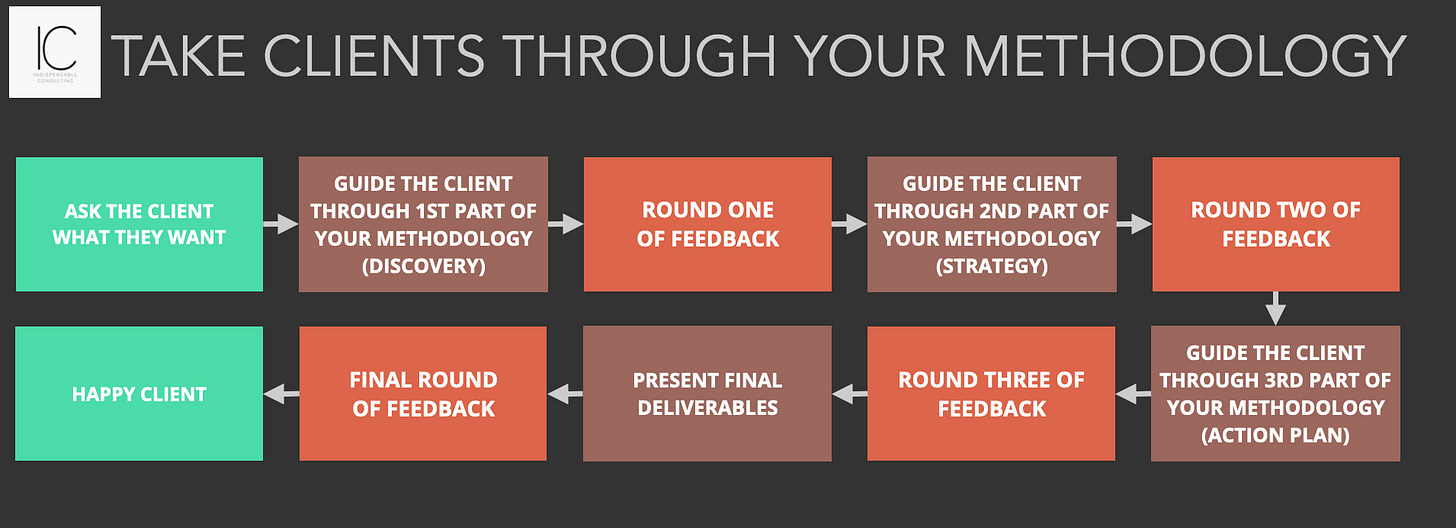The 'Want/Know' Problem
The fundamental mistake which leads clients to believe consultants will only tell them what they already know.
Hi, I’m Rich, welcome to my consultancy newsletter. Please subscribe and check out my best articles.
Why Clients Will Be Disappointed If You Give Them What They Want
Welcome to the consultancy doom loop
I suspect a common mistake for new consultants is to give clients exactly what they want and then find themselves with unhappy clients.
This happens like this.
In a new project, you begin by asking clients to describe what the outcomes look like.
Let’s imagine it’s a presentation.
Then you ask them to explain what contents you would like the presentation to cover.
Let’s imagine it’s an optimised sales process.
You ask them what does and doesn’t work - and drop the answers into the relevant areas of the sales process.
You ask them for feedback on what you’ve created and then adapt to their feedback.
etc…
At the end of the journey, you’ve created exactly what was in their heads in the first place.
And they’re left thinking
“Wait, we could have done this ourselves"
It’s easy to be confused about why a client is disappointed. After all, you checked in with them on every step of the journey.
I’ve written before about the importance of constant clarification. This is that you check in frequently with the client to ensure you’re on the right track (and you have a documented set of yeses they’ve agreed to).
However constant clarification has to be combined with a process and a mechanism for getting the right kind of feedback at the right time. This means rebranding your weekly meetings to status updates and being clear about how the feedback process works.
Know Your Methodology BEFORE You Begin The Project
The problem is you’ve turned yourself into a transcription service. You might give the client something that looks good - but it’s ultimately just transcribing what’s in their heads onto a document. That doesn’t help anyone.
Whenever you begin a project you have to decide:
What is the methodology we’re using to solve this problem?
If you don’t have a methodology to guide clients through, you’re always going to wind up simply asking clients what they think should be in the deliverables and then giving them exactly that.
We’ve written before about what separates good deliverables from bad ones and the skills you need to deliver them.
So what does a methodology look like vs. transcribing what the client already had in mind?
A better approach than the above would be:
Benchmark the current sales process against your benchmarks and their competitors.
Analyse data to see where people are dropping out of the process to identify the biggest pain points.
Speak to prospective customers and undertake UX research to get qualitative data on the issues
Identify and prioritise the key problems and their root causes - and the biggest areas for improvement.
Gather information on how others have overcome those challenges and separate them into people, process, and technology issues.
Engage with relevant stakeholders on the viability of improvements in each and adapt as needed.
Create a comprehensive action plan separated by work streams and share it with the client for feedback and final amends.
This is a simplified approach - but at least now you’re driving the client through a methodology to arrive at an outcome. You’re no longer asking clients what should be in the deliverable and simply giving it to them.
Combine this with specific check-in points where the client can submit feedback, see how the project is going and give approval.
You still need to constantly clarify your findings at each stage of the process for feedback and to check alignment - but you’re not letting the client drive the bus.
If you can’t figure out where you added unique value - you might need to rethink your methodology
As you move up pricing tiers, your methodology adapts more to the needs of the clients. However, it should always be clear in your methodology what the client can’t do without you.
This is the critical question - if you hadn’t been there and the client tried to solve the problem themselves - would they have ended up in a radically different place?
Can you point to a place in the process where your unique expertise added value the client otherwise wouldn’t have had?
At what point did your experience and expertise come into play in the process?
This is why having not just experience, but up-to-date expertise matters. In the example above, we can zero in on three areas where the consultant would provide a unique experience. This includes:
Up-to-date benchmarks you can use for your evaluation (or at least a criteria for benchmarking a client)
Deep knowledge of how other organisations are solving common problems. Your regular fact-finding calls are critical to long-term success.
Knowledge of the implications of the recommendations. Knowing the common stumbling points and issues from experience is key. These are things you can check with stakeholders.
These are the three areas (other than driving the client through the process) where the consultant added unique value and their expertise took the client to a place where they probably wouldn’t have otherwise ended up.
Join 1k+ consultants growing their practice by subscribing below (it’s free):
Thanks for reading



